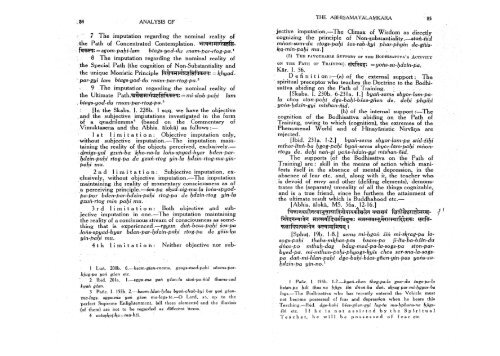ABHISAMAYALAMKARA
ABHISAMAYALAMKARA
ABHISAMAYALAMKARA
Create successful ePaper yourself
Turn your PDF publications into a flip-book with our unique Google optimized e-Paper software.
ANALYSIS OF<br />
7 The imputation regarding the nominal reality of<br />
the Path of Concentrated Contemplation. 3TT3TnTT«iW!f%-<br />
fkT* = sgom-pahi-lam btags-yod-du rnam-par-rtog-pm. 1<br />
8 The imputation regarding the nominal reality of<br />
the Special Path (the cognition of Non-Substantiality and<br />
the unique Monistic Principle fsf%fm&T%fw^*: == khyadpar-gyi<br />
lam biags-yod-du mam-par-rtog-pai 2<br />
9 The imputation regarding the nominal reality of<br />
the Ultimate Path.lfSCT^niT'fsi^fflrf^^^1!:<br />
= mi-slob-pahi lam<br />
. biags-yod-du rnam-par-rtog-pai 3 '<br />
: [In the Skabs. I. 228b. 1 sqq. we have the objective<br />
and the subjective imputations investigated in the form<br />
of a quadrilemma 4 (based on the Commentary of<br />
Vimuktasena and the Abhis. aloka) as follows ;—<br />
1st limitation: Objective imputation only,<br />
without subjective imputation.—The imputation maintaining<br />
the reality of the objects perceived, exclusively,—<br />
d/migs-yul gzuh-ba fyho-na-la lofts-spyad-byar bden-parhdzin-pahi<br />
rtog-pa de gzuh-rtog yin-la hdzin-rtog~ma-yin~<br />
pahi mu.<br />
2nd limitation: Subjective imputation, exclusively,<br />
without objective imputation.—The imputation<br />
maintaining the reality of momentary consciousness as of<br />
a perceiving principle.—ses-pa skad-cig-ma4a lohs-spyod*<br />
pa-por bden-par-hdzin-pahi rtog-pa de hdzin-rtog yin-la<br />
gzuh-rtog min pahi mti.<br />
•<br />
3rd limitation: Both objective and subjective<br />
imputation in one.—The imputation maintaining<br />
the reality of a continuous stream of consciousness as somdthing<br />
that is experienced.—rgyun dah-bcas-pahi ses-pa<br />
lohs-spyad-byar bden-par-hdzin-pahi rtog-pa de gnis-ka<br />
yin-pahi mu.<br />
4th limitation: Neither objective nor sub-<br />
I Lun. 200b. 6.—bsatn~gtan~rnGtns. gzugs-med-pahi snoms-parh<br />
jug-pa yah gzan etc.<br />
'*• 2 Ibid. 201a. 1.—sgyu-ma yan gzan-la ston~pa~nid thams-cad<br />
gzan.' • • . • - • •<br />
3 Pane. I. 153b, 2.—bcom-ldan-hdas hyah-chub-\yi bar yan gzan-<br />
Jfia-tags. sgyu-tria yan gzan ma-lags te.—Q Lord, S3, up to the<br />
perfect Supreme Enlightenment, (all these elements) and the illusion<br />
(of them) are not to be regarded as differfent items.<br />
4 h b<br />
THE <strong>ABHISAMAYALAMKARA</strong> 85<br />
jtive imputation.—The Climax of Wisdom as directly<br />
cognizing the principle of Non-substantiality.— stofi-md<br />
mfxon-surn-du rtogs-pahi ses~rab~kyi phar-phyin de-gniskq~min-pahi<br />
mu.]<br />
(5) THE FAVOURABLE SUPPORT OF THE BODHISATTVA'S ACTIVITY<br />
ON THE PATH OF TBAINING). tfqfoj: = yohs-su-hdzin-pa<br />
Kir. I. 36.<br />
D e fi n i t i on ;—(a) of the external support: The<br />
spiritual preceptor who teaches the. Doctrine to the Bodhisattva<br />
abiding on the Path of Training.<br />
[Skabs. I. 230b. 6-231a. I.] byah-sems sbyor-lam-pala<br />
chos ston-pahi dge~bahi-bses-gnen de. dehi phyihi<br />
„ yoh$~hdzin-gyi mtshan-nid.<br />
(h) of the internal support :—The<br />
cognition of the Bodhisattva abiding on the Path of<br />
Training, owing to which (cognition), the extremes of the<br />
Phenomenal World and of Hinayanistic Nirvana are<br />
rejected.<br />
[Ibid. 231a. I~2J byah-sems sbyor-lam-pa srid-zihi<br />
rnthar-ltuh-ba hgog-pahi byah-sems sbyorAam-pahi mhonrtogs<br />
de. dehi nah-gi yohs-hdzin-gyi mtshan-nid.<br />
The supports (of the Bodhisattva on the Path of<br />
Training) are : skill in the means of action which manifests<br />
itself in the absence of mental depression, in the<br />
absence of fear etc. and, along with it, the teacher who<br />
is devoid of envy and other (defiling elements), demonstrates<br />
the (separate^ unreality of all the things cognizable,<br />
and is a true friend, since he furthers the attainment of<br />
the ultimate result which is Buddhahood etc.—<br />
[Abhis. aloka, MS. 56a. 12-16.]<br />
[Sphut. 19b. 1-8.] sems mi-hgoh zih mi-s^rag-pa la~<br />
sogs-pahi thabs~mJ%has~pas bsam-pa ji-lta-ba-bzin-du<br />
dhos-po mthah-dag bdag-med-pa la-sogs-pa ston-parbyed-pcx.<br />
mi-mthun-pahi-phyogs^yis chos ser-sna-la-sogS"<br />
pa dah-mi-ldan-pahi dge-bahi-bses-gnen-yin-pas yons-st-<br />
hdzin-pa yin-no. 1<br />
I Pane. I. 155b. 1-2.—byan-chen theg-pa-la gsar-du zugs-pa-ia<br />
bstan-pa hdi thos na hjigs sin dhan-ba dan. sk.rag-par~mi~hgyur~ba<br />
lags.—The Bodhisattva who has recently entered the Vehicle must<br />
not become possessed of fear and depression when he hears this<br />
Teaching.—Ibid, dge-bahi bies-gnen-gyt lag-iu ma-hphons-na hjigssin<br />
etc. If h e i s n o t a « s i « t .2 d b y t h e . S p i r i t u a l<br />
T e a c h e r , h e w i l l b e p o s s e s s e d o f f e a r etc.












![Long Discourses of the Buddha [Digha Nikaya]](https://img.yumpu.com/32792419/1/164x260/long-discourses-of-the-buddha-digha-nikaya.jpg?quality=85)


